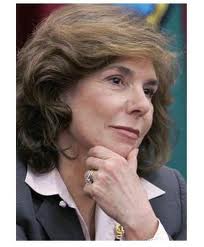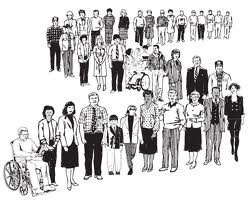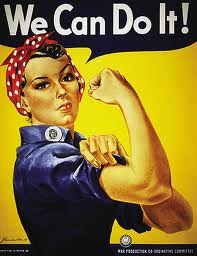A few years ago I recall watching the democratic political convention on television. Speaker after speaker, men and women, came to the podium. I noticed that most of the female speakers had the aspect of men. They wore pant suits, had short hair and wore only a meager assortment of jewelry. Makeup was almost nil. The image they projected was male.  Then Teresa Heinz Kerry, the wife of John Kerry, democratic forerunner, came before the audience. She appeared in a dress, was well made up and beautifully adorned in jewelry. What a striking difference. The image
Then Teresa Heinz Kerry, the wife of John Kerry, democratic forerunner, came before the audience. She appeared in a dress, was well made up and beautifully adorned in jewelry. What a striking difference. The image she projected was contrastingly female. Not sexy, but respectable and with class. Both types of female speakers were educated and powerful, yet I immediately thought Teresa Heinz Kerry is the correct role model of feminine power that I want my daughters to follow, not the male model of most of the female speakers.
she projected was contrastingly female. Not sexy, but respectable and with class. Both types of female speakers were educated and powerful, yet I immediately thought Teresa Heinz Kerry is the correct role model of feminine power that I want my daughters to follow, not the male model of most of the female speakers.
In this country, as a result of the feminist movement, women are gradually assuming positions of power and responsibility in politics, business, higher education, science and virtually every other facet of life. This is good, yet they are generally doing so in the image of men. I call such women “she-men.” On the other side we are seeing the feminization of men in this country. Men are being told to get in touch with their “feminine side” to become more sensitive and to ask themselves how they “feel” about important issues. The men who respond to such ideas I call girly-men. Women are becoming male and men are becoming female. A gender identity crisis is taking place in America. There are now whole university departments that deal with gender studies. I recently fell into a heated debate with my daughter, Lalita, when I suggested that she consider the model of Teresa Heinz Kerry instead of Senator Hillary Clinton, the powerful wife of former President Bill Clinton, who spoke at the democratic convention and whom I consider an example of the “she-man.” I was told that I was being sexist, but I disagree. So in this next series of installments I wish to express my views on the gender issue for my daughter Lalita.
Dear Lalita,
 There are two obvious factors that govern the gender issue: biology and technology. Biology means the basic fact that man and women are physically and emotionally different. Men create sperm, women create eggs. Men place sperm, women receive sperm. Men operate under the influence of testosterone and women operate under the influence of estrogen. Men are generally physically stronger and women are generally more emotional. These are some of the obvious differences between men and women that we all know.
There are two obvious factors that govern the gender issue: biology and technology. Biology means the basic fact that man and women are physically and emotionally different. Men create sperm, women create eggs. Men place sperm, women receive sperm. Men operate under the influence of testosterone and women operate under the influence of estrogen. Men are generally physically stronger and women are generally more emotional. These are some of the obvious differences between men and women that we all know.
The second factor is technology. Human beings have always used technology to improve their lives. It started with simple tools and eventually included such things as fire, the wheel, steam power and so forth. Today it has led to computers and digital technology. Technology has always been used to overcome and extend the physical limitation of life. The number one technology that has affected gender relations, and even the very nature of society, has been the contraceptive pill. For the first time in human history, starting barely half a century ago, the pill reliably freed women from their biological imperative, pregnancy. The consequences have been enormous.
society, has been the contraceptive pill. For the first time in human history, starting barely half a century ago, the pill reliably freed women from their biological imperative, pregnancy. The consequences have been enormous.
Lalita, I do not need to describe how the roles of women in society have changed and how this has affected gender relations during the past 50 years, but the problem is the pill appeared within just a few years whereas gender roles are rooted in biological nature that has evolved over millions of years and which have been worked out in human societies over thousands of years. This powerful technology is years ahead of society’s ability to absorb its implications and adjust to the new potential that women now have. So women naturally grasp the only role model they have for interaction with the outside world, namely the role of men. Hence the rise of the “she-man,” a masculine female. This has led to the development of feminism, a movement that has taken on significant political power. But feminism has not only worked to promote the female role in society, it has also contributed to the feminization of men by disenfranchising men from their traditional power roles. Hence the rise of the “girly-man.” The rise of both the she-man and the girly-man, while it might be one of the unavoidable stages a struggling society must go through when faced with a powerful contraceptive technology like the pill, is not a healthy situation for either of the sexes because it denies the biological nature of both sexes. It assumes that women can be like men or that men should be more like women. While this may sound simplistic and even trite, a more healthy alternative to redefining gender roles in modern societies is that women should be women first and men should be men first and from this point create their new cultural gender identities. Let me explain.
Apart from the obvious, as I have already stated, “Men create sperm, women create eggs…” I cannot say objectively what it means to be a man or a woman, but I can tell you, from my personal perspective, what being a man is. This, however, is completely subjective and is based on my culture, my personal upbringing and my personal experiences. Besides the basic biological facts, the state of being man or woman is so culturally conditioned that it is impossible to define. Long hair for woman; short hair for men? Dresses for women; pants for men? Working in the home for woman; working out of the home for men? Anyone who has lived for just a few decades or traveled even a little knows that fashion and cultural norms vary greatly. Styles change rapidly. It is impossible to say what being a woman or being a man is.
Lalita, we live in a world that is full of incredible diversity. It is amazing to travel from one land to another and witness the unbelievable range of human expressions of gender. However, one thing is certain, amongst all this diversity, the effects of a powerful technology like the contraceptive pill is changing even the most insulated, traditional and remote societies. The impact of the pill is global and therefore the effect on gender roles is global. A modern society like America is on the forefront of gender crisis and experimentation and therefore is in the greatest degree of transition to redefine its gender roles.
land to another and witness the unbelievable range of human expressions of gender. However, one thing is certain, amongst all this diversity, the effects of a powerful technology like the contraceptive pill is changing even the most insulated, traditional and remote societies. The impact of the pill is global and therefore the effect on gender roles is global. A modern society like America is on the forefront of gender crisis and experimentation and therefore is in the greatest degree of transition to redefine its gender roles.
Laying at the foundation of gender identity is biological reality and therefore, biologically speaking, there indeed is something objective called maleness and femaleness. This, to me, is the single most important factor that must not be overlooked as post contraceptive societies evolve and workout new gender roles. And as we have noted, above this biological reality is human culture, which, in an almost infinite number of ways, is constantly interpreting and reinterpreting this biological reality in terms of its gender roles. At present these roles, at least in this country, generally involve women emulating traditional male roles and men emulation female roles, the she-man and the girly-man. My concern about these roles is that they do not take into consideration the objective biological reality of maleness and females and therefore they are out of sync with biological reality. Instead of emulating the respective opposite gender roles, it would be better to start from the point of biological reality and build up from there. This is what I think Teresa Heinz Kerry or to cite another example, our current Secretary of State, Dr. Condoleezza Rice, have done.
 Lalita, I can not tell you how to do this. It is all too subjective. Only you can decide what it means to be a woman in America. All I can do is suggest that you first consult your feminine psychological and biological nature and work from that point. I only have a sense that this is what Teresa Heinz Kerry or Dr. Condoleezza Rice have done, whereas Hilary Clinton has not. Even though I do not find the masculine female identity of Hillary Clinton appealing, I do not fault her for it. I fear that in todays state of gender transition only the “she-man” model of female gender identity may be able to win an election and become president. It may be that the rest of society would not accept a Teresa Heinz Kerry or a Dr. Condoleezza Rice as president at the present time. In spite of this, Lalita, I encourage to consider the Teresa Heinz Kerry or Dr. Condoleezza Rice model of American womanhood as the best model of feminine identity. Stay away from the she-man model.
Lalita, I can not tell you how to do this. It is all too subjective. Only you can decide what it means to be a woman in America. All I can do is suggest that you first consult your feminine psychological and biological nature and work from that point. I only have a sense that this is what Teresa Heinz Kerry or Dr. Condoleezza Rice have done, whereas Hilary Clinton has not. Even though I do not find the masculine female identity of Hillary Clinton appealing, I do not fault her for it. I fear that in todays state of gender transition only the “she-man” model of female gender identity may be able to win an election and become president. It may be that the rest of society would not accept a Teresa Heinz Kerry or a Dr. Condoleezza Rice as president at the present time. In spite of this, Lalita, I encourage to consider the Teresa Heinz Kerry or Dr. Condoleezza Rice model of American womanhood as the best model of feminine identity. Stay away from the she-man model.
It is fun to play roles. In your young life you already play so many roles, daughter, student, friend, and in the future you will play many more roles, wife, mother, career woman, and so on. Each one of these roles has its unique set of rules and nuances. In a similar way, gender is just another role that you will play in life. In the last few installments I have explored some of the issues relating to gender and made some suggestions how you may go about creating your own unique feminine identity. If you recall the time we were driving from the desert into Riverside, I told you so many specific things about male and female roles and you were horrified at some of the ideas that I suggested. These were simply “shock value” statements meant to get you thinking about the issues and to challenge the she-man model that may be in your mind, but as you can see none of those ideas are stated here. They are all too subjective and culturally bound to be useful. So I opted to layout some general rules that may help you create your unique gender role. Boil it all down and what a man wants in a woman is an attitude of wanting to please her man. And I presume this is what a woman wants in a man. Of course, what constitutes pleasing varies between the sexes and between individuals, but the attitude of wanting to please each other is the key to success in gender relations. It is that simple. So just look at gender as one of the roles that you will play in life like any other role, except that it has a biological foundation. You are not actually any one of these roles, so do not be overly attached or repelled by any role that you may need to play. Each role is just a part of what makes you who you are. I do not even think you are the conglomerate of all the roles you play. You are much more.
Of course, how you play any of your roles will always be circumstantially and culturally conditioned, and so if you lived in France or India how you would play the role of mother, wife or career person will be different than how you may play it in America. If you are married to one man you may play the role of wife differently than if you were married to another man. So take satisfaction in knowing that gender identity is just one of many roles that you will play in life. Enjoy playing the role of woman. There is a lot of power in it. Both biology and society have endowed it with many advantages. Do not squander your assets of being a woman by trying to emulate a male role. It is good to be a woman.
